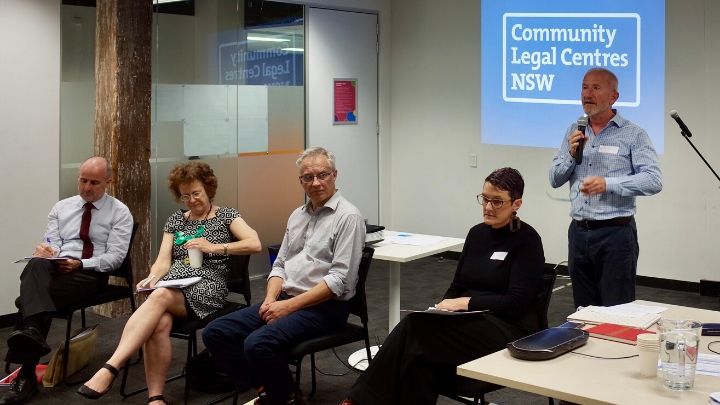
Geoff Mulherin, Anne Cregan, Simon Rice, Katrina Ironside and Tim Leach
The opening plenary session of the November 2019 Quarterlies posed the question “Do we need to be different in 2022?” to get the sector’s thinking caps on well ahead of tendering for State and Commonwealth funding in 2022. Introduced and facilitated by outgoing Community Legal Centres NSW Chair Katrina Ironside, the plenary featured three compelling visions for the future of the community legal sector posed by three external allies of the sector.
Professor Simon Rice, Director of Professional and Community Engagement at the University of Sydney, laid out a vision centred on four provocations. He argued that community legal centres need to forge our own clear role and purpose that is separate from what we are told by government to do, and that shouldn’t just rest on being “cheaper Legal Aid”.
-
Community legal centres need to be genuinely community based. Community embeddedness sets CLCs apart from straightforward contracted legal service providers and is important to identity. CLCs need to commit to genuine, regular, responsible community consultations to guide their direction, and community governance through involving members of the community on boards and management committees. If we commit to this, the unique edge we can bring is that we genuinely ;answer to the communities we grew from and are embedded in: “when you speak to us, you are speaking to community”.
-
Community legal centres need to be emphatically multi-/inter-disciplinary organisations.Justice means more than just providing discrete legal services to meet a specific need. CLCs should prioritise working more closely with other community services and adjust staff profiles of centres to shift the balance away from lawyers.
-
Community legal centres should be repositioned as human rights organisations. This will mean work will be recast in terms of international and local human rights laws: policy, advice and other work should all fit within a human rights framework.
-
Community legal centres should diversify funding. This means shifting away from dependence on Commonwealth and State funders, and leveraging the three elements above to build closer relationships with other NGOs and funding bodies.
Anne Cregan, Partner at Gilbert + Tobin, grounded her vision in the position that CLCs are likely to remain primarily government funded, and that they should prioritise a client-centred approach. She queried what might be different about the sector if it were to be designed today from the ground up based on those two principles:
-
Location: CLCs should be located based on client need rather than historical advocacy. Going forward, CLCs could therefore consider relocation to places more central to communities, and/or mergers in order to achieve scale.
-
Casework: CLCs should all be big enough and well-funded enough to carry out full casework rather than some only being able to provide advice. Casework is integral to CLCs’ law reform work and to giving accurate advice.
-
Staff retention and career pathways: CLCs should be able to offer decent wages and career progression.
-
Clear expectations from government: CLCs should prepare for government changing the way it manages CLC tender processes – at present the government treats CLCs differently to commercial firms in this regard. It is possible the government may apply to CLCs that same process it applies when tendering for other services i.e. it might define how much it is willing to spend on a particular area, and then select from tenders the proposal that offers the best outcomes for a particular cohort (based on some assessment of reasonable cost). This would go hand in hand with more reliable, consistent data collection from the sector. This would enable government to compare services and centres and to target services to priority clients in ways that government demands.
Anne argued that given the difficulties of lawyer retention in regional areas, CLCs should adopt a model whereby clients first speak to a high-level paralegal. The paralegal mightthen connect the client to appropriate services, which may or may not include involve higher-level legal work by CLCs.
Geoff Mulherin, Director of the Law and Justice Foundation of NSW, proposed a “General Practitioner” model for community legal centres, drawing parallels between the role of CLCs and the campaign, “I’m not just a GP, I’m a specialist in life”. He argued that the tender process will likely continue whether we like it or not, and as such, CLCs will need to identify a distinct role and gaps that only we can fill.
Geoff proposed a medical model: general practitioners are often a first contact point of contact, can themselves solve straightforward issues, and refer patients to relevant medical specialists and other appropriate social services. He suggested that generalists CLCs position themselves as “Legal GPs” and play a similar triage and referral role. Generalist CLCs would solve simple matters themselves through straightforward advice and assistance, and have close referral and working relationships with specialist services: specialist CLCs for particular areas of law, Legal Aid for casework and representation on more complex matters, other community/social services where applicable, and more. Generalist CLCs would be well-connected to community, have access to volunteers and prioritise maintaining strong relationships and referral pathways with other services. This model would then become CLC-driven, and carve out a unique role for CLCs in the legal assistance landscape, thus positioning us well for a future tendering process.
Geoff observed that many CLCs are already functioning in this GP role, but that CLCs are not necessarily claiming that role and identity.
Lively debate between the speakers and many audience participants ensued, discussing the benefits and shortfalls of each proposed vision. This discussion raised a common concern: reconciling the community-embedded nature of each CLC’s work, with the homogeneity that tendering often produces. While the path to resolving this tension is not yet clear, all in attendance agreed that it is necessary to shift from being reactive to Government demands, to setting the agenda ourselves. The three visions presented provide three suggestions for ways to achieve that goal.
